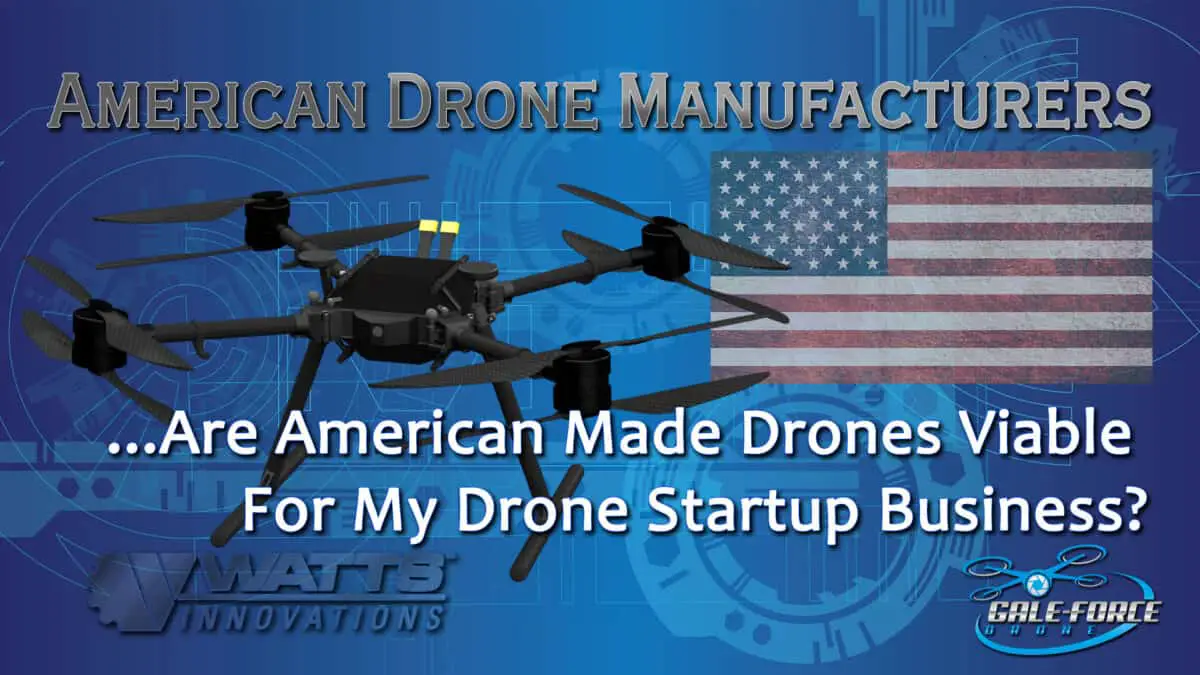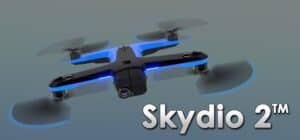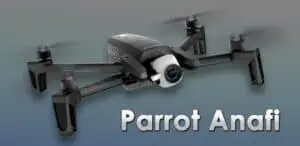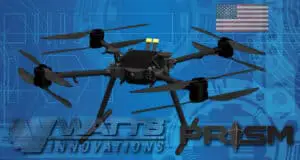
Are American Made Drones Viable For My Drone Startup Business?
As a startup Drone Business, you have many drone options to choose from. Chinese companies currently dominate the market with high quality, affordable equipment. However, there is some risk that geopolitical events may restrict U.S. businesses from buying and operating equipment sold by Chinese manufacturers. Below is your guide for how to navigate through this risk and ensure sustainable operations.
*Disclaimer* Gale-Force Drone actively utilizes DJI products and this article is not intended to advocate for or against DJI. My intent with this blog is to help you make a more educated decision when selecting the product line that will support you and your business for years to come, perhaps considering American made drones for your drone startup business.
Chinese Drone Dominance

In the early 2000’s, the only drones in the commercial marketplace were radio-controlled toys and hobbyist aircraft. The U.S. military began to surge its drone operations in Afghanistan and Iraq throughout the decade, but the technology did not yet have a clear commercial application.
In 2009, 3D Robotics (3DR) was the first American company to make a big bet on the emergence of commercial drones. Over the next five years, the company heavily leveraged external investors to launch its initial lineup of commercial- and consumer-grade drones. In the absence of a clear consumer market, its domestic competition was nearly non-existent.
Their problem: in 2015, a young Chinese company called DJI launched its Phantom 3, which built upon its earlier successful Phantom lineup. The Phantom 3 instantly became a best-seller around the globe. Since DJI had previously established a solid international presence as a consumer drone vendor, the fledgling American companies (such as 3DR) were unable to gain and maintain market share, and many evaporated out of the industry. Due to worldwide dominance, the company was able to reach significant economies of scale through mass production, driving down the retail price of their products, and thus, no other company could compete at these prices. In a single year, DJI established itself as the global leader in commercial drone production, with nearly zero competition.
And why wouldn’t they be? DJI’s drones are aesthetically beautiful, incredibly reliable, and among the most cost-effective prosumer products on the market. Their large consumer base leads to an endless number of peripherals and accessories, and the user support population extends beyond the company’s employees and into its aficionados; an extended myriad of zero-cost tech support resources.
As U.S. drone policy took shape between 2016 and 2020, prosumers (professional consumers) raced to enter the tidal wave of aerial photographers and surveyors. Options for American made drones for your drone startup business are not necessarily in the forefront, and for most niche applications, it could seem that the only cost-effective choice of drone vendors may be DJI. DJI is certainly the most notable brand.
Falling From Favor
DJI products, along with their Chinese colleagues, have been under some scrutiny since 2017. This is partially due to the companies’ products themselves, and partially due to the country in which they happen to reside.
One of the early Chinese technology casualties was the telecommunications giant Huawei. By the early 2010’s, Huawei was on a pace to overtake and dethrone the top two smartphone providers (Apple and Samsung). Throughout the 2000’s, the company had faced some legal battles regarding intellectual property (IP) infringement, and its equipment was subsequently banned from the U.S. commercial sector in 2012. By 2017, the company’s ties to the Chinese military and intelligence community gave rise to concerns about privacy and data collection. The restrictions increased to the point where U.S. companies could no longer partner with Huawei, which effectively halted its U.S.-based revenue. Since then, the UK and Sweden have followed suit by banning the company.
On a similar timeline, sister Chinese telecommunications company ZTE faced suspicions about its network infrastructure’s potential to enable Chinese surveillance over U.S. citizens, businesses, and government entities. Restrictions on ZTE began with a semiconductor partnership ban in 2018, and escalated to earning it a spot on the FCC’s list of national security threats in 2020.
In 2020, restrictions continued on Chinese-owned companies that produced social media applications WeChat and TikTok. In each case, the reasoning for the ban was a blend of privacy/surveillance concerns and economic warfare.
For its part, DJI was first banned by the U.S. Department of Defense in 2017, and the ban has since spread throughout the U.S. government. This restriction is, once again, borne of privacy/surveillance concerns that imagery of sensitive locations can be made available to the Chinese government for intelligence-gathering purposes. DJI had already faced its own IP battles by that point, so the story appears to be mirroring its telecommunications counterparts. By 2020, the U.S. government ban expanded to include not only all Chinese drone manufacturers, but also all manufacturers categorized as a “covered foreign entity” (which includes several countries that are not on friendly terms with the U.S. government at the time of this writing). There have been multiple investigations into the truth of the underlying allegations, and results continue to be mixed. Whatever the underlying truth, the federal government codified the Chinese drone ban in the American Security Drone Act of 2019.
Astute readers will note that the preponderance of sanctions have occurred since 2017, implying a political bias from the current administration. While a plausible opinion, it is important to note that many of these (and other) cases have a decades-long history of IP battles and bipartisan security concerns spanning multiple government departments. Moreover, the U.S. is not alone in its concerns about Chinese technology that has potential to be utilized by foreign intelligence services–several other western nations have expressed concerns about telecommunications security, and taken similar actions as the U.S. government.
Supplier Risk
In business terms, “risk” represents an uncertain situation or event that could have adverse effects in the future. As a business owner, you will want to minimize your risk wherever possible and consider searching for an American made drones for your drone startup business. One risk that companies watch closely is “supplier risk”, that is, the risk that your chosen source of equipment and support will someday cease to be available or affordable.
As a business owner, the level of risk you are willing to accept is a very personal choice. When selecting your equipment, remember that you are not making a one-time purchase; you are aligning with the manufacturer for accessories, software updates, replacement parts, upgrades, repairs, and warranty claims. This puts you in somewhat of a long-term relationship with that vendor. If you are subsequently prevented from continuing that relationship due to external factors, you reach a stopping point in maintaining and upgrading your professional equipment.
As a service provider, you should also be sensitive to your customers’ needs. If you plan to do aerial work for a federal government agency, you should expect that they will not allow a DJI (or any other Chinese) drone on their premises or at the project site. There is a similar risk for state/local governments and major government contractors. Even local businesses, realtors, and private customers could harbor privacy concerns that exclude service providers who use equipment from the “naughty” list. The equipment you select now could limit the customers you are able to support for several years.
Should DJI, and its companion Chinese drone manufacturers, ever be banned from the United States, it is impossible to predict how the restrictions may be implemented. For example, the drones themselves may still be sold in this country, but our portable devices may be restrained from running their applications. Or commercial restrictions and tariffs may limit which retailers will carry the products for consumer sales, creating a supply chain bottleneck that is certain to raise consumer prices.
In the most extreme case, an outright ban on purchasing new Chinese drone equipment will likely make allowances for those who have previously purchased the systems. This is the essence of “risk”; we simply do not know how a potential restriction will manifest itself, nor are we able to adequately plan and prepare for such a situation. For these very reasons, I strongly encourage you to research American made drones for your drone business.
Buying Guide
In general, for an entry-level imagery drone, you will want to look for the following qualities.
- Camera resolution. 1080 is the minimum you should offer, and 4K is the current standard in this industry. There are dozens of additional variables to describe the quality of the imagery, so we will keep it simple here with only the resolution.
- Battery endurance. Depending on the size of the job, a good rule of thumb is 20 minutes of flight for a small residential building (e.g. single-family house), and 30 minutes of flight for a large residential building (e.g. apartment) or small commercial complex. This can, and should, be divided into at least two batteries plus a backup (meaning, you should show up for each job with at least three fully charged batteries).
- Size. Although various drones can be approximately the same size when expanded for flight, many modern offerings can fold for storage and transportation. Do not underestimate the power of a compact drone for transportation. In most cases, you will want a case to store and transport your equipment in, and the cost of this case grows along with the drone size! Before buying a drone, make a plan for how you will transport it in your vehicle. Smaller drones mean a smaller payload, but they also fit into smaller vehicles.
- Accessories. You are not just buying an air vehicle; you are also buying a controller, carrying case, storage media, charger, and video editing software. Some drones are very proprietary, in that you must purchase the accessories that are custom-designed for use with the same brand. Others are more open, in that they can be supported by a variety of cases/media/chargers/software. Do yourself a favor and map out your entire package prior to making your first purchase.
DJI Alternatives
The following section highlights a few U.S. (and one European) drone manufacturers that are attempting to regain market share from their foreign competitors. This list targets entry-level commercial imagery drones appropriate for residential and commercial imagery, and is certainly not all-inclusive of every U.S. drone manufacturer; the number of options grow by the month.
Conclusion
In this article, I hope to give you some alternatives to the “beaten path” that most emerging drone entrepreneurs follow. DJI, as well as other Chinese companies, make amazing products; however, their future in the U.S. marketplace is difficult to predict, which adds risk to today’s young companies. If I was first getting into the market today, I might make some very different choices for my equipment!
Please feel free to contact me direct with any questions or comments. I welcome the interaction. You can find me on my website, on LinkedIn, Facebook, Instagram and Twitter. Just look me up as Gale-Force Drone.

How To Get Your FAA Part 107 Pilot Certification
If you are serious about making money with your drone, whether it be Real Estate, Aerial Inspections, etc., then you will need, from the FAA a 14 CFR Part 107 certification.
The best source for your training can be found by clicking on RemotePilot101. Jason Schappert is a pilot and author of 8 best-selling aviation flight training books. While studying and taking tests is not the most fun, Jason breaks it down into 10 easy to follow (at your own pace) video lessons. These lessons are straight and to the point giving you the exact knowledge, nothing less, nothing more than what you need to pass the exam. Additionally, he is continually updating the training to keep it relevant to any changes to FAA regulations. This membership is a 1-time subscription – for life! So when you’re 24 month renewal comes around, just sign in to RemotePilot101 and refresh your training.
Just remember, if you are flying commercially, you will need your Part 107 certification. It’s not hard, you can do it!






